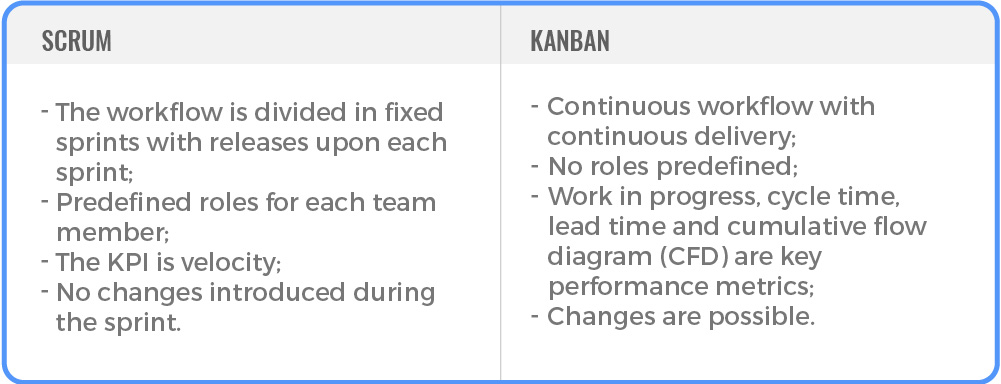That was predictable: outstaffing or managing virtual teams came along with a boost of digital products on the market. According to some analysts, in the next few years, about one-third of skilled full-time employees will work within remote development teams or hybrid teams.
Even though it may be a massive challenge to hire a skilled dedicated software development team, it’s just part of the mission. It requires extra efforts to get all employees on the same page. Therefore, it may be useful to acquire knowledge on hiring, managing and providing productivity of a technical team.
written by:
Alexander Arabey
Director of Business Development, Partner
That was predictable: outstaffing or managing virtual teams came along with a boost of digital products on the market. According to some analysts, in the next few years, about one-third of skilled full-time employees will work within remote development teams or hybrid teams.Even though it may be a massive challenge to hire a skilled dedicated software development team, it’s just part of the mission. It requires extra efforts to get all employees on the same page. Therefore, it may be useful to acquire knowledge on hiring, managing and providing productivity of a technical team.
Step 1. Effective recruitment of a dedicated software development team
Specific requirements help an outsourcing company come up with a list of candidates and conduct a few interviews to make sure they are qualified enough for your project.
After pre-screening you may want to give potential employees test tasks or discuss their code samples or schedule additional interviews - it’s up to you. At the interview, we suggest that you present your project in detail and explain what distinguishes it from other projects.
The onboarding of dedicated software development team members looks pretty much the same as it looks in in-office employees. There are several aspects that apply to the virtual team solely:
- As there is no onsite supervision of secure data, the remote team should be properly informed about security measures, customer data, and information storage.
- There might be a necessity in a workshop on progress monitoring tools and communication methods.
Step 2. The right manager
For the successful management of a remote software development team, you need an in-house manager with a solid technical background. Look for an experienced Team Lead, a Project Manager, a Product Owner, or let this task be yours.
If the newly-built team of the in-house and remote employees is cross-cultural, it’s important to provide maximum information about countries, cultures, and business ethics. The information should be positive. It is intended to eliminate stereotypes and inform team members on how cultural parameters impact the interaction process of the virtual team.
Step 3. Seamless workflow for remote teams
In addition to management issues that are common within leading in-house and remote teams, there are a couple of specific difficulties you’re likely to encounter. Here are the top issues to deal with:
- Cultural or language differences
- Communication
- Tracking the team performance
- Scheduling
- Integration into the corporate culture.
Cultural or Language Differences
Such differences may have a substantial impact on the communication inside the team, task prioritization, sharing personal initiatives, and critical thinking. About 30 years ago, Geert Hofstede first published a concept of Cultural Dimensions and specified the Six Dimensions of Culture. The concept is based on a large-scale study of IBM departments located throughout different continents.
What’s the practical use of this theory?
Cultures with higher Power Distance Index appreciate clear guides and directions, are less likely to share their initiatives or express their disagreement with the manager. Examples of such cultures include Malaysia, Philippines, Mexico, Russia, and other Asian and Eastern European countries. Be clear about tasks and deadlines. If you would appreciate initiative or creative solutions - inform your team in advance.
A higher power distance index is usually associated with lower Individualism. Representatives of collectivistic cultures are compliant, process-oriented, and are stronger influenced by corporate culture. They are better motivated by intrinsic rewards, gaining experience, and being able to help the team deal with responsible tasks.
For a virtual team manager, it is also important to understand the level of Masculinity or Femininity in culture, if this culture is Long-term or Short-term Oriented, what’s its Uncertainty Avoidance Index and Indulgence.
For example, in Asian countries expressing an explicit “no” in negotiations with a contractor may be considered impolite. Most often you can hear something like “we understand”, “yes, but…”, "mmm... I see", which actually means a refusal. Great focus on customer interests often forces Asians to agree on extremely complicated tasks or unrealistic deadlines.
Managers should be vigilant in navigating between these differences to help the company enjoy the benefits of a virtual team. It’s a good idea to inspire remote employees to share details about their cultures as a team-building experience. How to avoid cultural misunderstanding? The easiest way is just to ask the employees. They are also interested in making the team feel comfortable and are likely to appreciate the genuine interest of managers in their cultural traits. It’s a good practice to be perspective on project goals, expectations, and deadlines.
Communication between the remote team members
Effective communication may be a stumbling block when trying to successfully navigate virtual development teams in outstaffing and outsourcing.
According to Albert Mehrabian research, communication channels are not equal in their effectiveness. At the same time, a study by the University of Wisconsin states that meeting attendees “learn 200% more with face-to-face communication than with audio alone.”
Qulix managers believe that the smart use of advanced technologies and the Agile approach can be extremely useful for workflow organization. To synchronize teams in Agile, it’s important to use high-quality video conferencing for daily meetings (stand-ups), plannings, groomings, and retrospectives. According to Atlassian, most employees attend 62 meetings each month. Better communication at these meetings works to improve the processes, while poor technical equipment can complicate the processes.
Here are time-tested tips for a successful meeting:
- Set a clear agenda and keep it in front of you;
- If the agenda looks too impressive, break it into smaller chunks and create a separate short meeting for each;
- Invite only those team members, who are able to actively participate and bring something to the table;
- Communicate the idea that participants should feel free to leave and get back to work when they feel they can no longer contribute something valuable to the discussion;
- Stick to the meeting format and respect timing;
- Make sure the agenda contains key issues to be discussed to provide your team with time to get ready for it.
If the team is international, remind your managers to give instructions to the remote team in a crystal-clear manner. It makes sense to avoid ambiguous phrases, idioms or language jokes, no matter how funny and fitting they seem.
To overcome the distance barrier, some companies go ahead and install large screens to show the real-time workflow of employees and create a feeling of common office space.
If such solution looks too extravagant, basically it’s just enough to implement an effective information system which contains:
- a Source Code Management (SCM) system;
- an issue tracker;
- information storage or internal Wiki pages, where the team members can document or sketch their ideas and solutions;
- a convenient communication tool.
These are basic things that make the development-to-release route smoother. Try keeping things simple, as they are used daily.
To sum things up with communication issues, you should never underestimate the importance of each team member. Face-time is a valuable investment, as it gets people to commit and brings them together.
Tracking software development team performance
Indeed, virtual teams in outsourcing or outstaffing are slightly more difficult to control, so managers may often find themselves wondering, “how do I know what they’re up to?” or “how to make sure everyone is on the same wavelength?”
Agile methodology and proper technologies are able to facilitate not only communication but also tracking the performance of dedicated software development teams. If you’re still deciding on how to manage a team in outstaffing, you should consider Agile. Scrum or Kanban is simply perfect for smaller teams. It’s up to you, which framework to choose or to mix both. Just make sure it fits the needs of the project.
Certain metrics can be applied to both, for example, epic and release burndown and control charts, but most of KPIs would be different.
Despite certain difficulties in getting insights on the team performance, it is possible to monitor it quite effectively. Here are a few tips on how to do it:
- Be explicit about your expectations: you may either want to see carefully logged working hours or the final result, no matter how long it takes.
- It’s always useful to have a clear quantitative way of estimating the contributions of the remote employee. This way you are able to back up your position if you’re not very satisfied with results.
- You may want to make use of the time-tracking software. Let this technology be an added advantage to the team. Help employees understand that it’s a win-win situation: time-trackers will help them better manage their working hours without wasting time, be more effective, and get more bonuses.
Scheduling in outsourcing and outstaffing
Delegating tasks to remote teams offer great potential for enhanced productivity, but managing workers located in different parts of the globe is always a challenging factor.
If it’s impossible to find the time that falls in everyone’s working hours, use a creative approach. Qulix shares tested methods to eliminate this issue:
- Be ready for compromises: let half of all the meetings be convenient primarily to your domestic team or let the other half fit the schedule of your remote team.
- Use tools and services for easier scheduling in different time zones, for example, TimeBuddy, Spacetime (integrates with Slack), or other.
- You can record meetings for those, who can’t attend real-time. Just as well you can ask them to record their own videos in advance to share it at the meeting.
- Collect meeting notes and find a person to send feedback to all participants by email. Documenting minutes on shared space is also a good idea.
Integration into the corporate culture
Last but not least, one of the key goals is to build a community. Daily face-to-face interactions naturally promote the feeling of bonding and trust with the group. You don’t have this advantage when managing a remote technical team so it may lead to cohesion decrease.
It takes a lot of intent to develop a corporate culture that promotes the connection and chemistry between the remote team members.
- Schedule time for team-building. Use technologies and communication tools to create dedicated chats and spaces to celebrate events (birthdays and other) and project milestones (for example, successful tests or deployments).
- Promote the discussion of shared beliefs and commonalities.
- Be supportive if the remote team members face difficulties in daily tasks, but stick to accountability.
- Instead of micromanagement and diligent check of progress and figures, help the team focus on goals.
- Create a habit of daily check-ins in shared docs and spaces, chats, or at the meetings.
Remote communication can be challenging. Keeping track of the team member’s performance, organizing smooth processes, and keeping everyone engaged can be a hard task. However, if you build your own toolset and formulate the right approach, you can get the advantage of the flexibility and valuable ideas from the new team members. So it’s definitely worth it.
For more on Qulix partnership models, contact us at request@qulix.com or visit our website.

Contacts
Feel free to get in touch with us! Use this contact form for an ASAP response.
Call us at +44 151 528 8015
E-mail us at request@qulix.com











